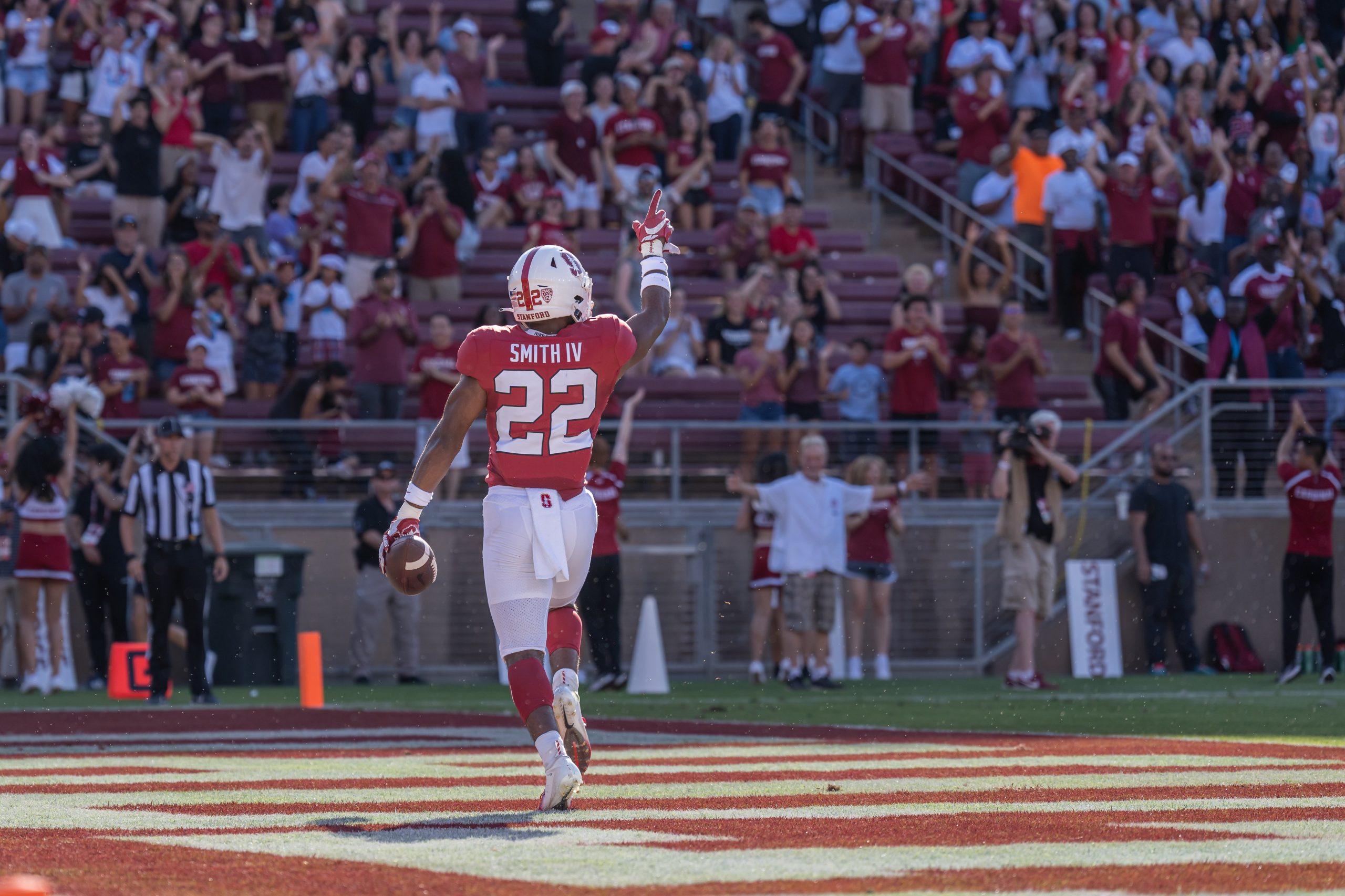If there’s one game Stanford (1-0, 0-0 Pac-12) should have circled on their calendar this season, it is this one.
The Big Game might feature Cal, but Saturday’s 4:30 p.m. matchup with No. 10 USC (1-0, 0-0 Pac-12) might be bigger. This is primetime, Saturday Night Football, with the eyes of the college football world on Stanford Stadium expecting to see the rebirth of a USC program under hotshot new head-coach Lincoln Riley. The rebirth of a program that represents the controversial new world of college football, with its NIL riches and 30-plus transfers on the roster. A program that is bolting from the Pac-12 at the first opportunity, after playing second-fiddle to Stanford and others for over a decade.
Fittingly, the program erasing tradition is the one accustomed to vacating wins.
There are so, so many storylines coming into this game — a tempest, between old and new in college football. But few, perhaps insultingly few, revolve around a Stanford team that has dominated this series in recent years and upset then-No. 14 USC in the Coliseum just last season.
What an opportunity for unfancied Stanford to plant its flag on home soil. Last week’s Colgate game taught us little, but it reminded Stanford fans of just how talented the passing attack can be. Fifth year captain Michael Wilson –– healthy after an injury-ravaged 2021 campaign –– shined, his 2 touchdown receptions showcasing his route-running and catch radius. Junior quarterback Tanner McKee had a full arsenal, and even if weapons like junior tight end Ben Yurosek and senior receiver Elijah Higgins were quiet, the sheer depth in the skill positions showed enough to get Cardinal fans excited about taking it to the Trojans through the air.
Unanswered questions remain on both lines, as expected. The O-line quietly dominated in pass-protection, as McKee and sophomore Ari Patu had clean pockets all afternoon in which to operate. Only once did a Colgate defender get a hit on a Stanford quarterback, and both tackles — senior Walter Rouse and junior Myles Hinton — were among the top five performers on offense, according to Pro Football Focus.
That said, Stanford moved the ball too inconsistently in the running game, given the lowly caliber of opposition. Scouting ahead, stopping the run happens to be a weakness for USC: the Trojans struggled to slow Rice’s (coached by former Stanford offensive coordinator Mike Bloomgren) power-run heavy ground attack. The ground game could be an opportunity, and if the line can continue to improve in run blocking, Stanford’s offense can be two-dimensional against USC.
On the other side of the ball, Stanford’s defense adjusted well to Colgate’s rushing attack as the game went on but struggled at times with a mobile opposing quarterback. The Trojans clearly will be a much sterner test, and Stanford’s ability to hold up the run against a USC squad that averaged nearly 7.5 yards per carry against Rice may dictate the Card’s competitiveness.
Ultimately, Stanford is trending neutral after Colgate. The win highlighted the team’s strengths while providing little insight into the weaknesses. Will those strengths be enough to propel Stanford to victory versus USC? Honestly… maybe? Stanford is clearly the underdog, but a once double digit spread shifted in Stanford’s direction early in the week.
There’s some good fundamentals to suggest an upset, too. This is a totally new-look USC team, who will start three newly-transferred wide receivers, two new running backs (including former Stanford starter Austin Jones) and a new quarterback. Playing USC now, versus later in the season, falls into Stanford’s hands, as the Trojans are still a work-in-progress and Lincoln Riley may still be finding his best team. On Stanford’s side, you have an uber-stable program and coaching staff, a home environment and a very dangerous passing attack. You can understand why a majority of the smart money in Vegas backed the Cardinal to cover.
Personally, I like Stanford’s odds here — this just feels like an archetypical upset. I see this as having three outcomes, each equally likely: USC blowing out Stanford, USC edging Stanford in a close game and Stanford pulling the upset.
Not bad odds for the team ESPN will ignore in the pregame. Here’s what the Cardinal should keep in mind in order to send a message to the rest of the Pac-12.
1. Get Tanner McKee into a rhythm
Tanner McKee’s quarterback play determines the ability of this Stanford team to contend with quality opposition. Simple analysis maybe, but as we saw in the Coliseum last year, the gunslinger is the man who can put it all together against the Trojans and enable the Cardinal to compete in a shootout. McKee was elite in the 42-28 upset win, going 16-for-23, for 234 yards, 3 total TDs and, crucially, no turnovers.
When in rhythm, McKee can lead Stanford to statement victories against the likes of USC, but inconsistency can affect his game. Take last week: In the first half, McKee was on song, going 19-for-21 with a pair of touchdowns. It was close to the perfect half for the quarterback. However, in the third quarter, McKee missed a wide-open Ben Yurosek on a vertical seam route, potentially costing the Cardinal a touchdown. The next play, McKee made a poor decision, throwing to nobody in particular and getting picked off. One bad play impacting another cropped up in McKee’s game last year as well, both in terms of decision-making (as we saw Saturday) and pocket presence under pressure — pressure on one play would lead to “happy feet” on the next.
As McKee continues to improve, he’ll iron out some of these wrinkles, but for Saturday, Stanford needs to make sure their quarterback is dialed in early. If not, this is a USC team that feasted on poor quarterback play in last week’s demolition of Rice, picking off four passes and returning three of them for scores.
2. Win first down
One of the ultimate cliches is to “make your opponent one-dimensional.” Ironically, Stanford needs to do the opposite against USC. We’ve discussed the struggles defending the run, and USC — featuring Stanford’s starting running back from last year, transfer Austin Jones — will pound the rock unless Stanford forces them to throw.
Key to this are the early downs. If Stanford can win reps against USC early on and force 2nd and 8 or more, the defense can begin to assert itself, forcing USC into obvious passing situations that will give Stanford’s stingy secondary chances to make plays. It would be great if, by the second half, we don’t know what the visitors will dial up on first down — we’d know the D-line was getting stops against the run.
Winning on 1st and 10 applies on offense, too. EJ Smith’s 87 yard score on the first play from scrimmage got the headlines last week, but that run aside, Stanford’s backs managed 77 yards on 25 carries (Smith himself averaged 3.1 yards per carry, ex-TD). Given Colgate’s talent level, these numbers are underwhelming. Stanford will need to improve consistency on the ground to stay on schedule versus a USC rush defense that struggled against Rice, giving up a pair of touchdowns and over 5.5 yards per carry to the Owls’s backs.
3. Turn around special teams
Pete Alamar’s special teams units have been a position of exceptional strength for Stanford for the last 10 years. Such consistent standards made the special teams struggles against Colgate a real head scratcher: Stanford fumbled the ball three times on punts, leading to a couple turnovers and the lone Colgate score. Even when things went “right,” the unit just looked off. For instance, several times junior returners Casey Filkins and Bryce Farrell would start too shallow on punts and have to backtrack or make an over-the-shoulder play to haul in a fair catch on a punt. Both returners looked uncomfortable, to the point where the basic mechanics of fielding punts looked awkward, and if the struggles continue, more mistakes are inevitable. Add in sophomore back-up kicker Emmet Kenney’s missed PAT, and it was a truly ugly day for Alamar’s unit.
It goes without saying that Stanford cannot afford any special teams mishaps against USC. And it goes without saying that Alamar, Shaw and the staff will be spending significant time this week to work out these issues. But in a meaningless game like Colgate, where the gap in talent makes any real evaluation difficult, self-inflicted errors on a usually-reliable unit jumped off the field as a major area of concern.
Pablo’s Picks of the Week:
- Stanford 35, USC 31
- Game I’ll be Watching: Alabama @ Texas
- Upset of the Week: Stanford aside, give me Vandy as a touchdown-plus dog over Wake Forest
Pablo will be in the booth Saturday to call the game on KZSU.





